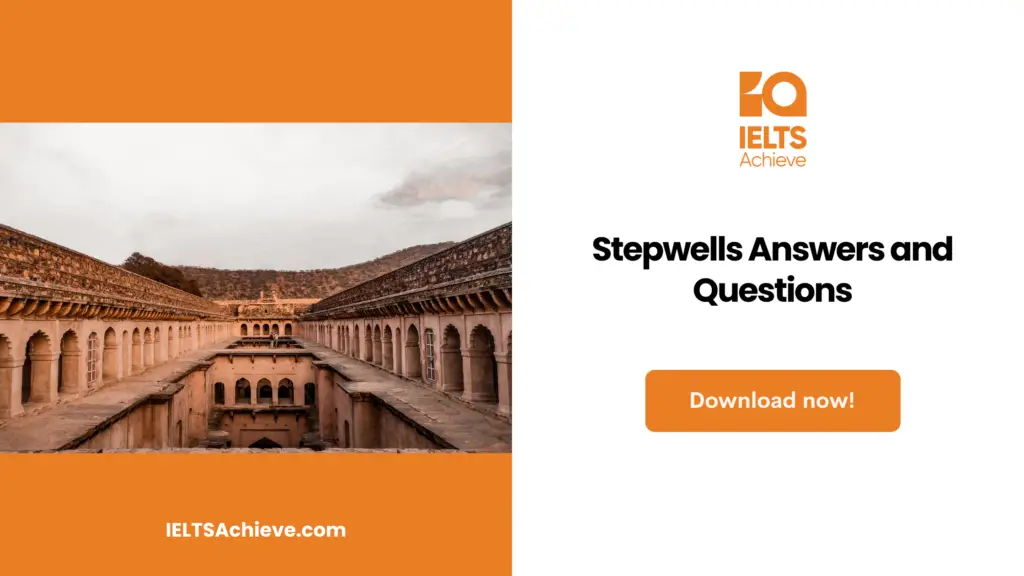The Blog post contains the following IELTS Reading Questions:
- IELTS reading locating information
- IELTS reading short answer question
- IELTS reading true/false/not given
Stay informed and prepared for success – Explore our comprehensive Reading Test Info page to get valuable insights, exam format details, and expert tips for mastering the IELTS Reading section.
IELTS Reading Passage: Stepwells

Stepwells
Almost 1000 years ago, stepwells were important to humans living in the driest parts of India. Although many stepwells were neglected, recent restoration of stepwells has brought them back to their former glory. Richard Cox went to north-western parts of India to record these marvellous monuments from ancient times.
The inhabitants of the present-day states of Gujarat and Rajasthan in North-western India devised a method during the 6th and 7th centuries for getting clean and fresh groundwater during the dry season for the purpose of bathing, drinking, watering animals and irrigation. However, the significance of the creation of stepwell goes beyond its practical application.
Stepwells are mostly complex by architecture, unique to a region, and vary vastly in shape and size. During their popular days, stepwells were a place where people gather, for leisure or to relax and as a place where all villagers worship but the lowest castes. Most stepwells have been discovered from around the desert regions of Gujarat (known as vav) and Rajasthan (called baori). Some stepwells also were discovered from parts of Delhi. Some were public spaces for the community situated in or near villages; others were built near roads as a place where travellers could take rest.
Stepwells are made of stone steps descending from ground level to the water source, in the underground, as it recedes after the rains. When the level of water is high, people have to descend only a few steps to take water; when the water level is low, the user has to walk down several steps.
Some stepwells have big open craters with hundreds of steps on every side, often in tiers. Other stepwells are more large, with long stepped pathways leading to the water via several storeys constructed from stone and supported by pillars. They also included pavilions that gave shelters to visitors from the scorching heat. But perhaps the most remarkable features are the complex decorative sculptures that adorn many stepwells. They display activities from fighting and dancing to everyday events like women combing their hair and churning butter.
After many centuries, thousands of stepwells were made throughout northwestern India, but the majority have now become unusable; most of it dilapidated and dry, as groundwater has been taken for industrial use and the wells dont reach the water table. Their condition became worse by the recent dry spells: Between 1996 and 2004 southern Rajasthan had suffered an 8 year drought.
Recently, some important sites in Gujarat have encountered restoration, and the state government in June last year announced that it plans to fix the stepwells throughout the state.
In the state’s ancient capital Patan, the stepwell of Rani Ki Vav (Queen’s Stepwell) is perhaps the best example. It was constructed by Queen Udayamati during the late eleventh century, but became silted up following a flood during the thirteenth century. In the 1960s the ASI (Archaeological Survey of India) started to restore it to its pristine condition. Rani Ki Vav at 65 metres long, 20 metres wide and 27 metres deep features 500 different sculptures carved into niches in the monument, depicting gods such as Vishnu and Parvati in various incarnations. In January 2001, this ancient structure withstood a devastating earthquake that was about 7.6 on the Richter scale.
Surya Kund in Modhera, another example, situated in the northern Gujarat, near the Sun Temple, built by King Bhima I in 1026 to honour the sun god Surya. It is a tank rather than a well, but displays the style of stepwell architecture, including 4 sides of steps that descend to the bottom in a stunning geometrical formation. The terraces have 108 small and complex carved shrines between the sets of steps.
Rajasthan also has a lot of wells. The old city of Bundi, 200 km south of Jaipur, is famous for its architecture, including its stepwells. Raniji Ki Baori for example was built by the queen of the Nathavatji, in 1699. The beautifully carved monument at 46 metres deep, 20 metres wide and 40 metres long is one of the twenty one baoris commissioned in the Bundi area by Nathavatji.
Almost 95 kilometres east of Jaipuri in the old destroyed town – Abhaneri, is Chand Baori, one of India’s oldest, deepest and beautiful stepwells. Next to the temple of Harshat Mata, the baori built in around 850 AD, consists of hundreds of steps that are placed along 3 of its sides, steeply descending 11 storeys, resulting in an extraordinary geometric pattern when seen from afar. On the 4th side, covered verandas supported by decorated pillars overlook the steps.
The Neemrana Ki Baori is still in public use and is located just off the Jaipur–Delhi highway. It was constructed around 1700, it is 9 storeys deep, with the last 2 levels under the water. At ground level, there are eighty six colonnaded openings from where the visitors descend 170 steps to the deepest water source.
Due to many years of neglect, many of these stepwells from the medieval period have been saved by the Archaeological Survey of India, which has acknowledged the importance of conserving them as part of our country’s rich history. Tourists travel to see stepwells in remote corners of northwestern India to enjoy these architectural marvels from a thousand years ago. It serves as a monument of creativity and artistry of the old civilisations and of the importance of water to humans.
Unlock your full potential in the IELTS Reading section – Visit our IELTS Reading Practice Question Answer page now!
Recommended Questions:
Renewable Energy IELTS Reading Question with Answer
Stepwells Reading questions
Questions 1-5
This reading passage has six paragraphs, A–F. Which paragraph contains the following information? Write the correct letter, A-F, as your answer to each question. Note: You may use any letter more than once.
1 Richard Cox went to north-western parts of India to record the stepwells from ancient times.
2 During the 6th and 7th centuries, people from Gujarat and Rajasthan created stepwells to get clean and fresh groundwater during the dry season.
3 Most stepwells have been discovered from around the desert regions of Gujarat and Rajasthan .
4 The most remarkable features of the stepwells are the complex decorative sculptures that adorn many stepwells.
5 Rani Ki Vav was constructed by Queen Udayamati during the late 11th century.
Questions 6-9
Answer the questions below.
Choose NO MORE THAN THREE WORDS from the passage for each answer.
6 Where is Neemrana Ki Baori situated?
7 What part of some stepwells provided shade for people?
8 Which climatic event, which took place in southern Rajasthan, is mentioned in the article?
9 Who are frequent visitors to stepwells nowadays?
Questions 10-14
Do the following statements agree with the information given in the reading passage?
Write
- TRUE if the statement agrees with the information
- FALSE if the statement contradicts the information
- NOT GIVEN if there is no information on this in the passage
10 Examples of ancient stepwells can be found all over the world.
11 Stepwells had a range of functions, in addition to those related to water collection.
12 The stepwells found in Delhi are more attractive than in other places.
13 It took them several years to construct the stone steps of stepwells.
14 The city of Bundi is situated 200 km south of Jaipur.
Enhance your skills in identifying information as True, False, or Not Given. Click here to discover expert strategies and techniques for mastering this question type in the IELTS Reading section.
Unlock your full potential in the IELTS Reading section – Visit our IELTS Reading Practice Question Answer page now!
Recommended Questions:
Renewable Energy IELTS Reading Question with Answer
Stepwells Reading Answers
1 Paragraph A
2 Paragraph B
3 Paragraph C
4 Paragraph E
5 Paragraph H
6 Jaipur-Delhi highway
7 Pavilion
8 Drought
9 Tourists
10 False
11 True
12 Not Given
13 Not Given
14 True

We hope you found this post useful in helping you to study for the IELTS Test. If you have any questions please let us know in the comments below or on the Facebook page.
The best way to keep up to date with posts like this is to like us on Facebook, then follow us on Instagram and Pinterest. If you need help preparing for the IELTS Test, join the IELTS Achieve Academy and see how we can assist you to achieve your desired band score. We offer an essay correction service, mock exams and online courses.

